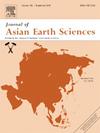Integrated chemostratigraphy and detrital zircon geochronology of the Ediacaran–Cambrian transition in the Western Anabar Uplift: Implications for the Neoproterozoic evolution of the northern Siberian Platform
IF 2.7
3区 地球科学
Q2 GEOSCIENCES, MULTIDISCIPLINARY
引用次数: 0
Abstract
The Terreneuvian strata of the Anabar Uplift (northern Siberian Platform) represent one of the reference sections for the periodization of the Early Cambrian geological record and global correlation. The age of the underlying Staraya Rechka Formation remains unclear due to a lack of biostratigraphic data, equivocal carbon isotope record and controversial geochronological age constraints. Herein we present the detailed chemostratigraphic (carbonate carbon isotope analysis) and geochronological (U-Pb analysis of detrital zircons) study of the Staraya Rechka Formation in the Western Anabar Uplift. Our data reveal that this evaporite-associated carbonate succession accumulated in the terminal Ediacaran within 550–540 Ma and is unconformably overlapped by the Nemakit-Daldyn Formation no older than 537 Ma. Hence, the carbonate isotope record of the Western Anabar Uplift lacks the BACE isotope excursion. At the beginning of the accumulation of the Staraya Rechka Formation, the clastic material in the paleobasin was derived from the Central Taymyr Fold Belt and crystalline basement of the Siberian Platform. In contrast, detrital zircons in the upper Staraya Rechka and basal Nemakit-Daldyn formations mostly originate from the rift magmatism that occurred in the northeastern Siberian Platform around the Ediacaran–Cambrian transition.
求助全文
约1分钟内获得全文
求助全文
来源期刊

Journal of Asian Earth Sciences
地学-地球科学综合
CiteScore
5.90
自引率
10.00%
发文量
324
审稿时长
71 days
期刊介绍:
Journal of Asian Earth Sciences has an open access mirror journal Journal of Asian Earth Sciences: X, sharing the same aims and scope, editorial team, submission system and rigorous peer review.
The Journal of Asian Earth Sciences is an international interdisciplinary journal devoted to all aspects of research related to the solid Earth Sciences of Asia. The Journal publishes high quality, peer-reviewed scientific papers on the regional geology, tectonics, geochemistry and geophysics of Asia. It will be devoted primarily to research papers but short communications relating to new developments of broad interest, reviews and book reviews will also be included. Papers must have international appeal and should present work of more than local significance.
The scope includes deep processes of the Asian continent and its adjacent oceans; seismology and earthquakes; orogeny, magmatism, metamorphism and volcanism; growth, deformation and destruction of the Asian crust; crust-mantle interaction; evolution of life (early life, biostratigraphy, biogeography and mass-extinction); fluids, fluxes and reservoirs of mineral and energy resources; surface processes (weathering, erosion, transport and deposition of sediments) and resulting geomorphology; and the response of the Earth to global climate change as viewed within the Asian continent and surrounding oceans.
 求助内容:
求助内容: 应助结果提醒方式:
应助结果提醒方式:


